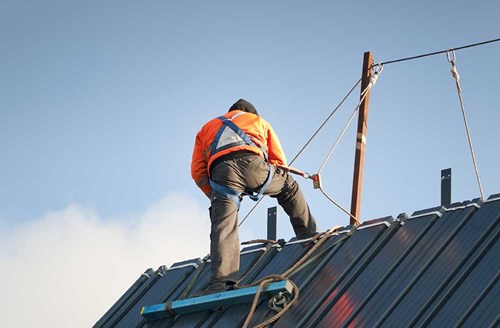Ian Hollingworth, Claims Manager at ECIC, explains the different health and safety risks associated with labour-only and bona-fide subcontractors.

It is widely recognised that the UK construction industry is suffering from a shortage in skilled workers. With an ageing workforce and potential changes to visa legislation following Brexit, this has potential to escalate further. The roofing sector, like many others, could be affected too.
To mitigate against this shortage many contractors may have become increasingly reliant on outsourcing work to subcontractors, giving them the flexibility to upscale their workforce based on demand. But bringing in ‘subbies’ on site, inevitably, has its own considerations and risks. Roofing contractors must fully appreciate the differences between bona-fide and labour-only subcontractors and what their responsibilities and requirements are to them from a health and safety perspective.
Labour-only subcontractors
Labour-only subcontractors generally work under the direction of the roofing contractor who will typically provide materials for the job. In the eyes of the law this is regarded as a master and servant type relationship. As such, the roofing contractor’s duties towards labour-only subcontractors are the same as to their own staff. Their health and safety documentation and procedures should reflect this. Roofing contractors must recognise the specific skill and experience of a labour-only subcontractor and consider additional health and safety procedures where necessary. If a labour-only subcontractor has an accident on site, the roofing contractor may be liable if they cannot provide evidence to demonstrate risks were properly considered and reduced to the lowest possible level and adequate protection was put in place to safeguard the worker concerned.
Bona-fide subcontractors
In comparison, bona-fide subcontractors are generally deemed to be specialist contractors who are responsible for their own systems of work and control the work undertaken by their employees. A bona-fide subcontractor is responsible for managing their own health and safety risks for their own element(s) of a contract. When bona-fide sub-contractors are hired, the roofing contractor should satisfy themselves that the bona-fide subcontractor adopts safe working practices and produces suitable risk assessments and method statements. They should also ensure they carry suitable insurances to cover the works they are undertaking.
CDM 2015
It is also important to note that the main contractor on a project will retain responsibility for overall health and safety for a site as detailed in the Construction (Design and Management) Regulations 2015. The main contractor has a duty to clearly and effectively communicate health and safety measures, and matters relating to risk management to the roofing contractor and the roofing contractor’s bona-fide subcontractors which usually takes the form of a site induction.
The continuing emphasis on health and safety is justified by the 27 per cent increase in construction fatalities in the past year with falls from height accounting for the biggest proportion (24 per cent) of deaths at work. These underline the continued importance of embedding a health and safety culture that is outlined clearly to all those involved–on any basis in a contractor’s business.
There could also be serious economic implications for businesses failing to comply with health and safety regulations following changes to the sentencing guidelines for fines imposed on businesses found guilty of health and safety offences.
Due to the wide bracket of fines under the new guidelines, mid-sized roofing businesses could face a fine similar to that of a much larger company, with much deeper pockets, or even a custodial sentence for the most severe cases. The best way to avoid this is to have an effective and robust approach to complying with health and safety laws that cascades throughout the workforce.



